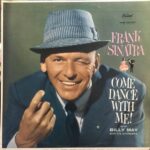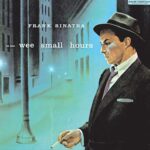
When Harry Met Frankie
On July 13, 1939, Frank Sinatra’s first professional recordings took place, together with the Harry James orchestra. There are many stories about how Frank and Harry met, but everything indicates that it happened like this:
In June 1939, Harry, who had just left Benny Goodman’s orchestra to try his luck with his own formation, heard Frank on the radio, through the WNEW station, which broadcast live the performances that took place daily in the Rustic Cabin, a restaurant-show where Sinatra worked.
The next day Harry drove to the Rustic Cabin and asked the owner “about the singer.” “We don’t have a singer,” said the manager of the Rustic. “We have a master of ceremonies who sings a little.” That’s how he introduced Sinatra, at that time an arrogant young man who might as well serve you a rack of ribs as sing you a Cole Porter song, convinced that he was going to be bigger than Bing Crosby himself.
Harry offered Frank an audition. Sinatra appeared without musical arrangements, (something essential in those times) he approached the pianist, told him what he wanted to sing, in what key, and started singing. And he left everyone speechless. That day there were many people called to audition, but the musicians said that when they heard Sinatra, he was the one. There was no doubt about it.
There were only 10 songs recorded commercially by Frank Sinatra and the Harry James Orchestra. All of them constitute a declaration of their compatibility and the possibilities of their professional relationship, but unfortunately, they also mean a musical “coitus interruptus“, since the two artists separated before reaching the inevitable climax that they undoubtedly could have reached. Success did not accompany the Sinatra-James tandem either in recordings or in concerts. The lineup coincided with Tommy Dorsey’s orchestra during a concert at the Sherman Hotel in Chicago; Dorsey was looking for a replacement for his male vocalist Jack Leonard and offered the position to Sinatra. Despite the difficulties, Frank had faith and great affection for Harry James and his orchestra, and the thought of abandoning them made him suffer, but he knew that signing Dorsey was the right move for his career and family life. he; His daughter Nancy would be born in June 1940, and business was so bad in James’ orchestra that they could barely afford to pay Frank the $75 from his stash. When Sinatra accepted Dorsey’s offer, James told him “If we don’t do better in the next six months, try to get me in too.”
As a barometer of their individual fortunes, the Sinatra James team’s most memorable collaboration, “All or Nothing at All,” on its original release sold a mediocre 8,000 copies after many months gathering dust on store shelves. At that time, 10,000 was acceptable and 15,000 was an event. But 4 years later, when both Harry James and Frank Sinatra were considerably popular, the Columbia label reissued “All or nothing at all“, to compensate for the effects of the musicians’ strike, during which recordings could not be made. They managed to sell a million copies almost immediately.
Sinatra would call his time with James “a wonderful 6-month experience,” describing his former boss as “a really great guy with real knowledge as a musician.” Sinatra learned a lot from Harry. He learned about orchestral conducting and a lot about phrasing. They both admired each other. Harry always knew that Sinatra was going to be a big star because he had great ability.
















